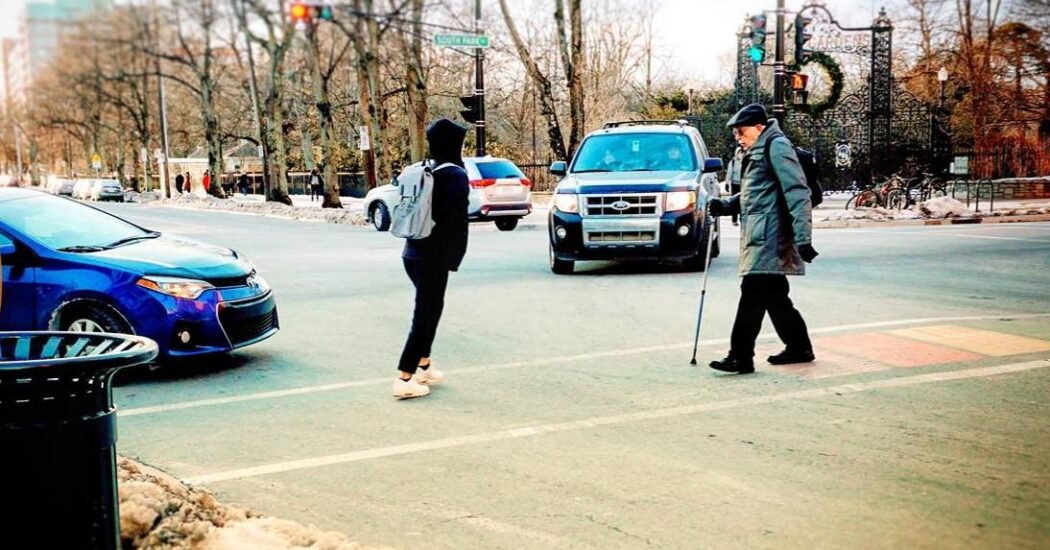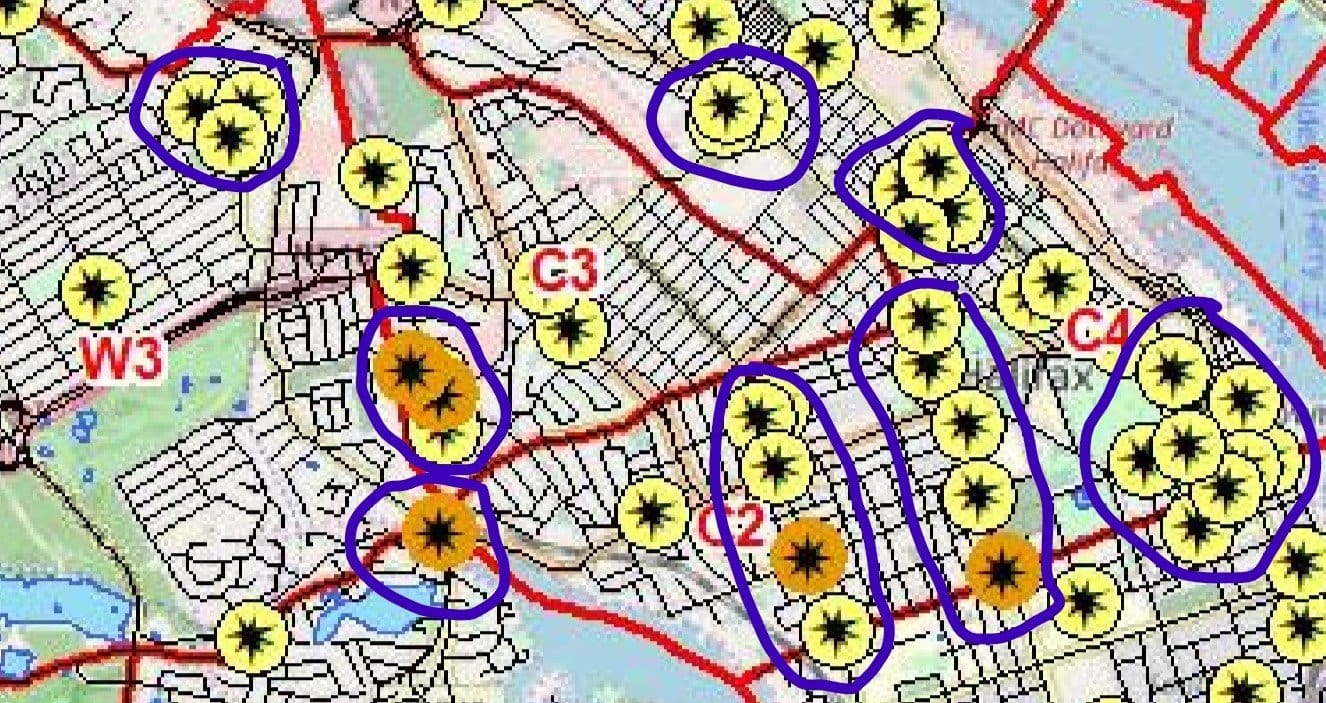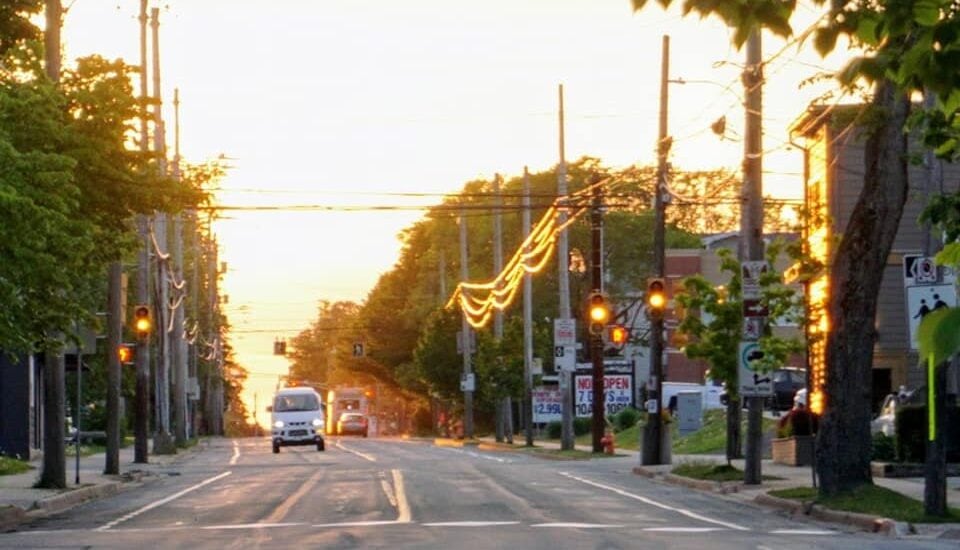
KJIPUKTUK (Halifax) – This is a grim time of the year for Halifax vulnerable road users. Police confirmed to me there were seven incidents involving pedestrians between 19 and 26 October, resulting in eight pedestrian victims.
An additional pedestrian was reported hit on the wide and dangerous Chebucto and Connaught intersection on 27 October.
This morning, a cyclist is reported hit at the Vernon and Quinpool intersection.
For comparison, last week in Ottawa, which has over double the population of HRM, there were eight confirmed pedestrian incidents, and one cyclist struck.
Although this spike is usually blamed on more hours of darkness and lower visibility, incidents often occur during daylight hours, peaking at around 3pm.
Nonetheless, many crosswalks are dimly lit because street-lights are often not positioned directly over and on both sides of crosswalks.

Some councillors, such as Shawn Cleary, have boasted of improvements in pedestrian safety during 2019 and 2020, but this is a premature conclusion:
- 2019 yielded approximately the same number of pedestrian victims as 2013.
- Four pedestrians, all seniors, were killed during 2019.
- Two further senior women were killed while lawfully using crosswalks in February and April 2020.
- All ten pedestrians killed since January 2018 were over 55 years old.
- Incidents were up 33% this September from the previous September, with October also looking no better or worse than previous years.
This demonstrates no sign at all of any short or long term improvement in walking/wheeling conditions and safety.
Recent incidents are in locations with very obvious and multiple safety deficiencies from the perspective of vulnerable road users – including wide intersections which offer no protection whatsoever other than an unreliable legal right of way. Few drivers seem to be aware of the need to yield the whole crosswalk to pedestrians and most do not even see them at all, as we are not in their direct line of sight, nor are they primarily thinking about pedestrians. At such locations danger can develop quickly and cannot always be predicted, as traffic turns quickly across the crosswalk from all directions.
Incidents are often severe because people have no protection from impact by vehicles. This year to the end of September, 37% of pedestrians hit experienced moderate to fatal injuries.

So what is happening to improve conditions for vulnerable road users? Halifax now claims to have a “Vision Zero” road safety plan in place, but as has traditionally been the case the planned actions (so far) appear to be determined and directed solely by traffic staff.
If you have already found this year’s actions, you’re doing well. They’re buried within a report to Regional Council and include a commitment to request speed limit reductions in four unspecified neighbourhoods and ten new signalized intersection locations with leading pedestrian intervals, which give pedestrians a few seconds head start on turning traffic and reduce pedestrian incidents at these locations by 13%.
This is the response I obtained from HRM when I enquired about progress on key requirements identified in the 2018 Road Safety Framework, including an action plan that should be developed specifically relating to the ten worst types of pedestrian collisions:
“Progress to the collision database has been made and staff are now able to identify and focus recommended improvements on top (overall) injury frequency locations. This is evident by the 13 in-service road safety reviews completed in 2019 for which staff are proceeding with short/medium term recommendations; and the ten locations currently under review through the MicroTraffic video analytics project for which the municipality received grant funding through Aviva Canada. That report is expected to be finished in early 2021 for possible implementation in 2021/2022.
“Staff are also still working on improving the analytics of the internal database whereby causal factors and specific types of collision data can be gathered for each of the emphasis areas.”
Is Halifax doing anything different to the traditional approach of incremental annual progress in limited specific locations, chosen by engineers? It is hard to understand how.

A Vision Zero strategic plan should identify the roads and locations where most incidents occur (referred to as a “high injury network”, as shown in this police pedestrian incident report from November 2019), how the incidents happen, what specific countermeasures will need to be adopted, how effective they are, how much funding is required and where they will be implemented.
Vision Zero is far more than a “top down” approach where safety adjustments are determined by engineers. It involves genuine participation by the community and clearly identifies and prioritizes those most prejudiced by unsafe conditions – children, the disabled, people of colour, seniors and residents in areas of affordable housing, often next to arterial roads.
Equity is a core requirement. An equitable approach to road safety changes the status quo, the focus of efforts, and ensures vulnerable road users are not paying the ultimate cost for infrastructure that greatly prioritizes the movement of traffic, namely car commuters at peak times, over the safe and efficient movement of people.
In Halifax, step 1 of Vision Zero requires:
1. An overall policy aim and objective which recognises that measures which provide safety for vulnerable road users are not desirable, they are essential. It is not the same as expenditure for more roads, or even new libraries, BRT and a ferry. These are all much needed and valuable core services. However appropriate measures that allow us to walk, wheel and cycle safely according to our own unique abilities are both a human right and essential in urban areas.
2. Clarity regarding the higher levels of incidents on artery roads and intersections, and a specific plan for addressing that.
3. Identifying why fatalities usually involve seniors, how they can be consulted and included, and how their unique safety needs can be both assessed and addressed.
4. Ascertaining the core issues causing danger for pedestrians – wide, multiple lane crosswalks – and what is needed to adapt them so they are safe for use, such as pedestrian refuge islands or a protected phase where traffic is stopped while pedestrians cross.
5. Recognition that able, younger adult pedestrians should not be our main focus when determining whether pedestrian infrastructure is adequate. Would we recommend a child, an elderly citizen or a physically and mentally disabled pedestrian weave their way across a multiple lane crosswalk with no refuges and no infrastructure at all? This needs addressing, urgently.
6. Recognition that no more pedestrians should be subjected to tests. We do not volunteer to it, nor should there be a need. We have adequate historical collision data – this can be used to formulate an HRM-wide pedestrian safety action plan.

Having things done to and decided for pedestrians, wheelchair users and cyclists by engineers without really understanding what their unique safety needs are and how to meet them is Old School, not Vision Zero.
It doesn’t work because it’s generic, the decision making isn’t completed by those who have personal experience of (and are most prejudiced by) the safety issues, and it doesn’t account for everyone’s very different abilities.
For example: Can an elderly or disabled person get far enough across a wide multiple lane signalized intersection crosswalk with a five second head start to really make a meaningful difference to their safety and comfort?
Vulnerable road users of all ages and abilities are not volunteering to perform dangerous stunts across unsafe multiple lane crosswalks for the benefit of further incident data and to slow, incremental progress.
If we can start with the needs of our weakest road participants and work backwards, we have equity, engagement, and real progress with increased safety for those in need of it the most.
Is this approach too ambitious, unrealistic, airy-fairy, prohibitively expensive? No – Halifax must address embedded and consistent danger on Halifax’s crosswalks, which account for around 60 to 70% of pedestrian incidents every year. This isn’t a “war against cars”, an overturning of any hierarchy, prioritizing a “special interest group” or a “one trick pony”, nor a revolution in transport of any kind.
The nub of an effective, equitable pedestrian safety plan is the need to work out how people can cross the road safely at locations where they have every right to expect a thorough level of thought and consideration both to their unique needs, and their fragility as vulnerable road users.
It is obvious from existing incident data and analysis such as that provided here, here and in Halifax’s monthly pedestrian incident reports what the issues are, why they are an urgent priority, and why fundamentally vulnerable road users cannot continue shouldering the burden of unprotected and dangerous crosswalks or for regular, often severe incidents on crosswalks to be an unfortunate but necessary side effect of maintaining traffic flow.
If you are concerned and affected by lack of safety as a vulnerable road user, please contact your councillor and 311 by email with your concerns and include this article.
Request that the long-promised pedestrian road safety action plan addressing the worst ten collisions (see 2018 Road Safety Framework, page 67) is developed urgently in accordance with Vision Zero methodology, along with the other specific action points and plans that relate to vulnerable road user safety. Specific actions required to address danger for cyclists are at page 68.
Request that those most affected by dangerous crosswalks and roads are identified and prioritized, and that we develop a tool-kit of robust safety countermeasures and adaptations that can be used to adapt unsafe crosswalks and roads for safe use by all, HRM wide.
See also: Councillors survival guide to safer streets, not just for councillors
If you walk, cycle or use a wheelchair and are affected by road safety issues, please join HRM Safe Streets for Everyone. If your local crosswalk needs a crosswalk flag, please contact the Crosswalk Safety Society. Please remember to report issues affecting your safety to our municipal authorities using the 311 service.
With a special thanks to our generous donors who make publication of the Nova Scotia Advocate possible.
Subscribe to the Nova Scotia Advocate weekly digest and never miss an article again. It’s free!



